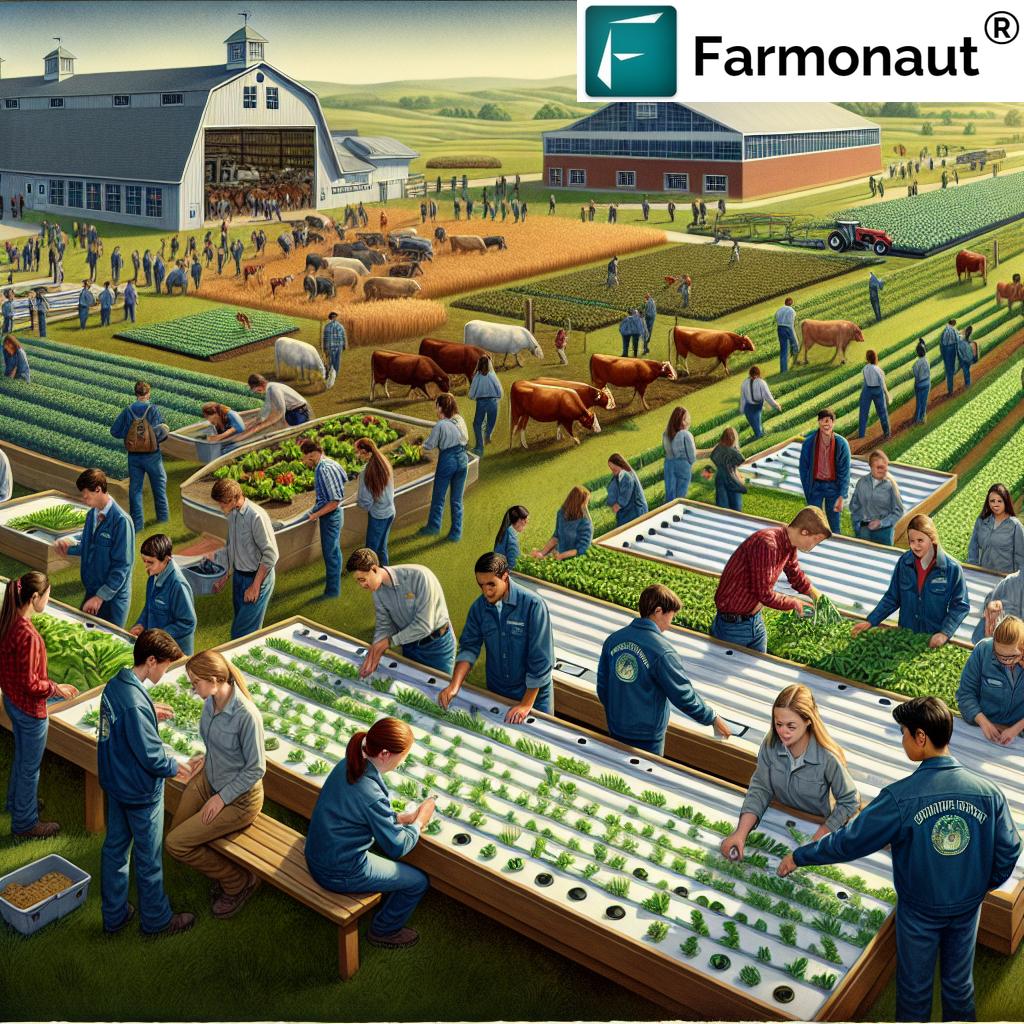Wisconsin & Maryland Farmland Preservation Program 2025: Securing Agricultural Heritage and Sustainable Futures
“Over 1.1 million acres are enrolled in Wisconsin’s Farmland Preservation Program, safeguarding vital agricultural land for future generations.”
Introduction: Why Farmland Preservation Remains Vital in 2025
In an era defined by rapid urbanization, industrial expansion, and persistent pressure on agricultural land, the farmland preservation program has emerged as a critical tool for safeguarding our agricultural base. States like Wisconsin and Maryland are at the forefront in the nation, developing and maintaining forward-thinking programs that ensure sustainable futures for both food security and rural economies. As we navigate 2025 and beyond, the urgency to protect agricultural heritage and support environmental conservation grows each year.
This comprehensive guide explores the landscape of farmland preservation programs, with a close look at the Wisconsin Farmland Preservation Program (FPP) and Maryland Farmland Preservation initiatives. We will cover their inner workings, compare approaches, highlight technological advancements, and offer actionable insights for farmers, policymakers, and advocates.
Understanding Farmland Preservation: Purpose, Mechanisms & Impact
Farmland preservation refers to a set of policies and initiatives specifically aimed at protecting agricultural land from being converted to non-agricultural uses—such as residential, commercial, or industrial development. These programs are not only about sustaining food security and the economic viability of rural areas, but also about preserving ecosystem services (like water filtration and carbon sequestration), sustaining biodiversity, and combating urban sprawl.
- Safeguards the land base required for food production
- Maintains the viability of farming as an economic sector
- Preserves open space and environmental benefits
- Supports rural communities and their heritage
- Reduces fragmentation and speculative loss of prime farmland
Wisconsin Farmland Preservation Program 2025: A Model for Sustainable Agriculture
The Wisconsin Farmland Preservation Program (FPP), established in the 1970s, is one of the nation’s oldest and most robust efforts dedicated to farmland conservation. Administered jointly by the Wisconsin Department of Agriculture, Trade, and Consumer Protection (DATCP) and county governments, the program is designed to incentivize farmers to keep land in agricultural use through a unique set of tax credits and planning protections.
Wisconsin FPP: Goals and Principles
- Ensure prime farmland is protected from conversion to non-agricultural uses
- Promote sustainable farming practices and stewardship of natural resources
- Support local economies and maintain rural character
- Control urban sprawl by using strategic zoning approaches
How FPP Works: Key Elements
-
Eligibility & Participation:
- Landowners enroll eligible land in a Farmland Preservation Plan developed at the county level and aligned with state guidelines
- They must comply with soil and water conservation practices determined by the county and the DATCP
- Land is protected via exclusive agricultural zoning districts or through formal contracts
-
Incentives & Benefits:
- Tax credits for continuing agricultural use of land and maintaining specified conservation standards
- Protection from certain forms of local government-imposed assessment and some regulatory restrictions
- Eligibility for technical support through county extension and conservation offices
-
Evolving with the Times:
- Incorporates advanced practices such as precision agriculture and regenerative methods
- Encourages use of remote sensing technology and data-driven insights—as seen with platforms like Farmonaut
- Integrates climate-smart adaptation to buffer against extreme weather events and shifting climatic patterns
-
Focus on Local Control:
- Counties and local municipalities have significant say in management through a decentralized approach
- Plans are tailored to address specific regional needs, market dynamics, and challenges
The continued adaptation of the Wisconsin farmland preservation program through 2025 is evident in its encouragement of advanced tools and data systems, helping farmers improve productivity and lower their environmental impact. Such technology integration aligns economic sustainability with environmental stewardship and long-term land conservation.
Access real-time monitoring, precision agriculture advisory, and much more with the Farmonaut app, designed for rural and urban farmers, governments, and agri-professionals.
For developers and ag-tech companies: Farmonaut provides a robust Satellite API and detailed API Developer Docs for integrating advanced land monitoring, NDVI analysis, and resource optimization directly into your platforms for 2025 and beyond.
Maryland Farmland Preservation 2025: Balancing Growth and Sustainability
The Maryland Agricultural Land Preservation Foundation (MALPF), established in the 1970s, is another key defender of farmland in the Baltimore-Washington corridor and rural Maryland. In 2025, with urban sprawl and suburban development accelerating, its work is more vital than ever in ensuring the longevity of agriculture as the backbone of the regional economy.
Maryland’s Strategy: Conservation Easements and Incentives
-
Easement Purchase Program:
- MALPF purchases agricultural conservation easements from willing landowners
- These easements restrict non-agricultural development, ensuring farmland remains productive in perpetuity
- Focus is on prime and productive farmland, targeting areas most threatened by conversion
-
Direct Benefits and Cost-Sharing:
- Landowners receive a lump-sum payment or annuity, providing financial security
- Additional grants support the adoption of sustainable farming methods and diversification of farm income
-
Ongoing Stewardship:
- MALPF provides ongoing stewardship, monitoring land use and compliance through annual inspections
- Technical assistance is provided for the integration of new technology and regenerative practices
-
Addressing Urban Encroachment:
- Strong emphasis on local planning, in cooperation with county governments
- Zoning regulations and comprehensive land use planning protect the region’s agricultural base
Maryland farmland preservation ensures the preservation of both small and large-scale family farms, helping maintain food security, farm income, and the environmental health of the Chesapeake Bay watershed. These policies are helping protect biodiversity, sustain water quality, and provide critical ecosystem services that benefit the entire state.
“Maryland’s Agricultural Land Preservation Foundation has preserved more than 340,000 acres since its inception in 1977.”
MALPF 2025: Highlights and Modernization
- Combination of permanent easements and renewable contract terms to balance flexibility with permanence
- Integration of digital mapping, blockchain-based traceability, and satellite monitoring—demonstrating the future-facing nature of Maryland’s agriculture preservation
- Proactive engagement with younger farmers and landowners to maintain family farming traditions
For enhanced ease in traceability and environmental compliance, you can learn more about Farmonaut’s blockchain-based product traceability solution—enabling farms and agribusinesses to establish trusted supply chains and meet regulatory standards effectively.
Comparative Summary Table: Wisconsin vs Maryland Farmland Preservation Program 2025
| Program Element | Wisconsin (Estimated Values, 2025) | Maryland (Estimated Values, 2025) |
|---|---|---|
| Acres Preserved (annually) | ~1,100,000 (total enrolled) | 340,000+ (total since 1977) |
| Funding Allocated (2025, USD) | ~$28 million (state + county) | ~$26 million (state + federal grants) |
| No. of Participating Farms (est.) | Over 13,000 | Around 2,300 |
| Main Conservation Practices | Soil erosion control, nutrient management, cover cropping, rotational grazing, riparian buffer maintenance | Permanent easements, wetland preservation, forestry best practices, nutrient reduction, urban sprawl mitigation |
| Policy Highlights | Decentralized, county-led plans; tailored zoning | Permanent, state-purchased easements; voluntary participation |
| Duration / Contract Terms | 10-15 years (contracts); Permanent zoning overlays | Perpetuity (permanent), some renewable terms (7-10 years) |
| Environmental Impact | Estimated 110,000+ tons CO2 equivalent avoided/year, robust biodiversity maintenance, improved groundwater recharge | Estimated 75,000+ tons CO2 equivalent avoided/year, watershed improvements, significant habitat protection |
Beyond Wisconsin & Maryland: The Broader Importance of Farmland Preservation Programs
Farmland preservation programs across the nation have established themselves as indispensable for both maintaining the viability of farming programs and ensuring food security. As climate and market uncertainties grow, these strategies play a crucial role in:
- Combating urban sprawl and protecting open space
- Maintaining biodiversity and ecosystem services
- Ensuring the economic futures of rural regions
- Promoting sustainable land use through conservation practices
- Providing resilience to climate change and maintaining community food systems
As of 2025 and beyond, leading-edge technology is shaping these efforts, providing powerful tools for safeguarding and monitoring agricultural land across the nation.
For organizations seeking to manage extensive landholdings and maintain best practices at scale, the Farmonaut Large Scale Farm Management system provides a scalable and efficient platform, accessible via web or mobile, designed to optimize operations from anywhere.
Sustainable Farming & Technology Solutions in Farmland Preservation
The integration of technology is a distinctive feature in the evolution of farmland preservation programs in both Wisconsin and Maryland. Modern satellite-based monitoring, AI-powered analysis, and digital record-keeping now supplement traditional stewardship.
-
Remote Sensing & Satellite-Based Monitoring:
Satellite platforms, like those we build at Farmonaut, deliver real-time analytics for crop health, soil moisture, and land use changes. NDVI, NDWI, and multispectral analytics provide accurate, timely data to optimize conservation and resource management. -
AI-Driven Decision Support:
Systems like Jeevn AI Advisory supply predictive analytics, helping farmers anticipate environmental risks, improve yields, and meet conservation requirements. -
Blockchain-Based Traceability:
Blockchain solutions aid in creating transparent, tamper-proof records for compliance and land use planning, which is increasingly demanded by state agricultural agencies and consumer markets.
To support emissions reduction targets, explore the Farmonaut carbon footprinting solution—empowering farm operators and policymakers to track and report CO2 and GHG emissions, facilitating sustainable agricultural practices and compliance.
Additionally, advanced crop, plantation, and forest advisory tools are available to support proper irrigation, soil health, and water resource optimization.
For financial institutions and individual farm owners, the Farmonaut crop loan and insurance verification modules use satellite data to streamline claims and risk assessment—helping both lenders and borrowers under the scope of farmland preservation programs.
Challenges and the Path Forward in Farmland Conservation
Despite ongoing success, farmland preservation programs in Wisconsin, Maryland, and other states must adapt to evolving challenges in 2025 and the coming decade:
- Rising Land Values: Urban and suburban market pressures push prices upward, making conservation commitments harder to afford for some landowners.
- Limited Funding: Sustaining adequate funding requires constant effort at both state and county levels, especially as demands on agricultural land increase.
- Policy Complexity: Ensuring policies balance flexibility for farmers with the need for long-term conservation is an ongoing policy design struggle.
- Generational Transition: Engaging younger farmers and facilitating farm succession is essential to keep agricultural land in active, local hands.
- Technology Integration: While technology presents new avenues for effective stewardship, it also requires investment in digital literacy and infrastructure.
- Public Perception: Achieving broader understanding of the crucial value of farmland—beyond its monetary worth as developable land—is key for policy support.
The path forward involves strong public-private coordination, continued education, and the proliferation of accessible, affordable digital tools to empower landowners. As example, satellite-based monitoring and blockchain traceability help meet both regulatory and sustainability targets. Initiatives to encourage farm succession and affordable access to land for new farmers will also be critical as generational shifts reshape America’s rural landscape.
For rural cooperatives and agri-businesses, the Farmonaut Fleet Management system offers complete oversight of machinery and field logistics—minimizing downtime and improving productivity in line with modern farming program standards and conservation requirements.
Farmonaut Subscription Pricing: Affordable Solutions for Future-Focused Land Stewards
No matter the scale of your operation—from small family farms to county-wide statewide conservation programs—Farmonaut subscriptions provide affordable, scalable access to the full suite of farm management, compliance, and environmental impact solutions.
FAQ about Wisconsin & Maryland Farmland Preservation Program 2025
What is a farmland preservation program?
A farmland preservation program is a structured initiative aimed at protecting agricultural land from conversion to non-agricultural uses, such as residential or industrial development. These programs safeguard land for future generations, support rural economies, and promote sustainable food systems.
How does the Wisconsin Farmland Preservation Program work?
The Wisconsin Farmland Preservation Program (FPP) is administered by the DATCP and county governments. It uses tax credits, zoning protections, and required conservation practices to incentivize farmers to keep their land in agricultural use, following tailored county-level preservation plans.
What is the role of MALPF in Maryland farmland preservation?
The Maryland Agricultural Land Preservation Foundation (MALPF) purchases conservation easements from willing landowners to ensure farmland is protected from development. This provides financial compensation and technical assistance to farmers, maintained through annual monitoring.
Are technological tools like satellite monitoring used in preservation?
Yes, technology is increasingly used for monitoring and verifying land use compliance. For example, Farmonaut’s satellite solutions provide real-time insights into crop health, land cover, and conservation practice verification, supporting both regulatory compliance and operational efficiency.
Who is eligible for these programs in Wisconsin and Maryland?
In Wisconsin, eligible participants are farmers and landowners who comply with county and state conservation requirements. In Maryland, participation is typically open to landowners with qualifying farmland who agree to long-term or permanent conservation easements.
What are the environmental benefits of farmland preservation?
Environmental benefits include reduced greenhouse gas emissions, preserved open space, improved water quality, biodiversity support, and the maintenance of ecosystem services which are all vital for sustainable rural communities and the wider environment.
How do these programs help with climate change adaptation?
By safeguarding agricultural land and promoting sustainable practices, these programs enhance resilience against extreme weather events, preserve carbon sinks, and support regionally-adapted food systems—essential steps in meeting the sustainability goals of 2025 and beyond.
Conclusion: Farmland Preservation as Pillar of Our Agricultural Future
Farmland preservation programs in Wisconsin, Maryland, and across the United States have proven themselves as essential pillars, supporting not just food security and economic vitality, but also the cultural and environmental heritage at the heart of rural landscapes. With 2025 marking a renewed focus on sustainability, climate adaptation, and technology-driven solutions, the preservation of America’s agricultural land remains a vital priority.
Wisconsin Farmland Preservation Program showcases the benefits of local control, adaptable planning, and modern incentives, while Maryland Farmland Preservation delivers a model for permanent, strategic easement-based protection. Both approaches are united in their commitment to rural resilience, sustainable agriculture, and ongoing economic development.
Technology has emerged as a key enabler. Platforms like Farmonaut provide the affordable, scalable tools needed to monitor compliance, optimize land use, and support climate-smart farming well beyond 2025. Our mission is to empower landowners, agribusinesses, and governments with cost-effective insights, transparency, and operational efficiency, supporting the shared goal of sustainable agricultural futures.



Discover more on sustainable agriculture and land preservation with Farmonaut.
Empowering the future of rural economies, food security, and environmental stewardship.










